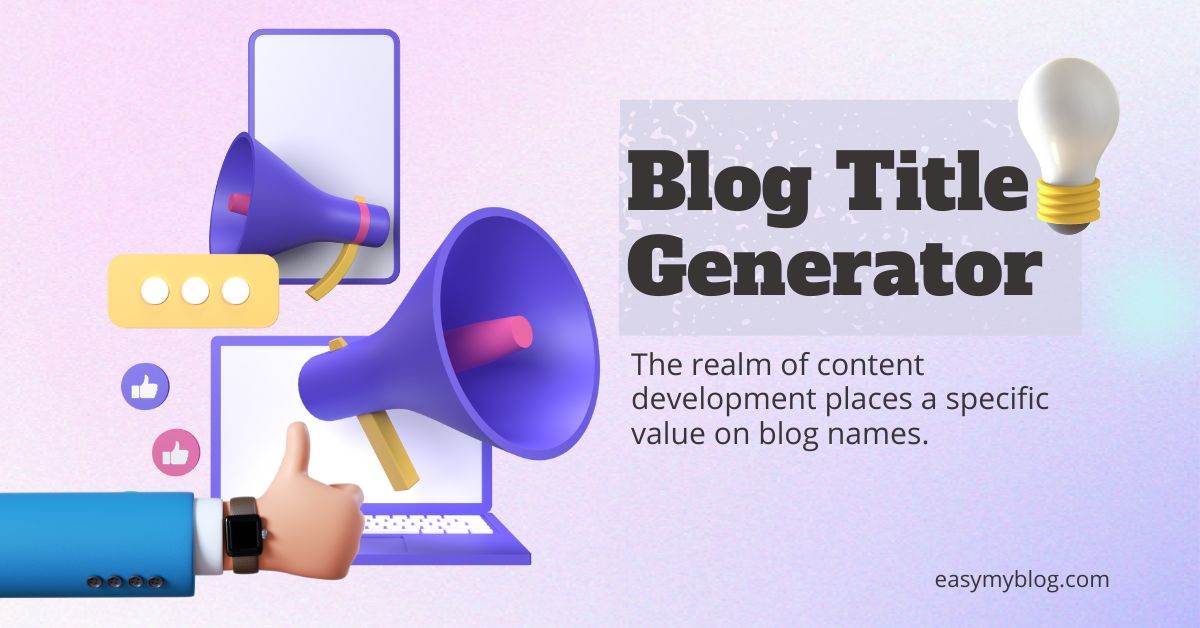The realm of content development places a specific value on blog names. They serve as the entry point to your posts, give readers their first impression of you, and determine whether they click through to read your content or not. Writing intriguing and captivating headlines takes skill, but what if you could partially automate the process? This is where a title generator might be useful.
We’ll discuss the idea of a title generator, its significance in content marketing, and how to build your own blog title generator from scratch in this extensive guide. This tutorial contains something for everyone, whether you’re an experienced blogger hoping to simplify your content development process or a newcomer looking to improve your writing abilities.

Understanding the Significance of Blog Titles
a. The Role of Titles in Content Marketing
The initial point of contact between your audience and your material on a blog is the title. They act as a succinct yet essential summary of what your content is about, affecting readers’ decisions to click through or continue scrolling. For blogs to get and keep followers, they need catchy titles.
b. The Power of Compelling Titles
The attention, curiosity, and promise of value are all factors in compelling titles. They ought to be interesting, enlightening, and pertinent to the subject. Additionally, well-written titles can arouse readers’ curiosity or sense of urgency, luring them to continue reading.
c. SEO and Blog Titles
The SEO of a blog depends heavily on the title of the post. In order to increase the visibility of your blog article in search engine results, they should include pertinent keywords. A decent blog title achieves a mix between human appeal and SEO optimisation.
What Is a Blog Title Generator?
a. How Blog Title Generators Work
Blog post titles can be generated with the use of tools or algorithms that employ user input, keywords, or established templates. To create interesting and pertinent titles, they make use of linguistic trends, data analysis, and creativity.
b. Types of Blog Title Generators
Different kinds of title generators exist, including hand-crafted tools, AI-driven generators, and plugins built into blogging platforms. Different levels of customization and automation are available for each kind.
c. Pros and Cons of Using Blog Title Generators
Title generators can help you save time and inspire new ideas. However, they might not always come up with excellent names, and relying too heavily on them might result in content that is unoriginal or bland.

Creating Your Own Blog Title Generator
a. Step 1: Define Your Blog’s Niche and Audience
Identifying your target audience and learning about their wants and preferences should come first. To write titles that resonate with your audience, define the specialty for your site.
b. Step 2: Collect a List of Keywords and Topics
Make a list of interesting subjects and keywords for your niche. These will act as the starting point for creating titles.
c. Step 3: Use Tools and Algorithms
To help with title generation, investigate the available tools and algorithms, such as custom scripts or natural language processing (NLP) models.
d. Step 4: Combine Keywords and Templates
Create title templates with your keywords in them. To keep your titles interesting and compelling, create variants.
e. Step 5: Refine and Review Generated Titles
Examine the generated titles for appropriateness, originality, and SEO enhancement. Adjust as necessary to make sure they fit the objectives of your blog.
Tools and Resources for Title Generation
a. Online title generators
Check out tools like TweakYourBiz, Title Generator by SEOPressor, and Portent’s Content Idea Generator that generate titles online.
b. Tools for Keyword Research
Find appropriate keywords to include in your titles by using keyword research tools like Google Keyword Planner, SEMrush, and Ahrefs.

c. Tools for Title Analysis
You may evaluate the success of your titles using tools like CoSchedule’s Headline Analyzer and Sharethrough’s Headline Analyzer.
d. Platforms and Plugins
Numerous platforms have integrations and plugins that might help with title generating. For this, WordPress, for instance, has a large number of plugins.
Best Practices for Using Title Generators
a. Juggling creativity and SEO
Strive to strike a balance between titles that are reader-friendly and are optimised for search engines.
B. Testing Your Titles with A/B
To find the titles that perform the best in terms of engagement and click-through rates, run A/B tests.
c. Refrain from Clickbait
Avoid using clickbait strategies when designing attention-grabbing titles because they could damage your credibility.
d. Keeping Your Relevance
To match readers’ expectations, make sure your article titles appropriately reflect their content.

Case Studies: Successful Title Generator Implementations
a. HubSpot
The Ideas Generator by HubSpot offers customers three keyword-based title suggestions. The technology has assisted content marketers and bloggers in streamlining their content development procedures.
b. BuzzSumo
Users can use BuzzSumo’s content research and analysis tools, which include headline analysis, to help them come up with catchy titles and other material.
c. The Content Idea Generator at Portent
With its inventive and captivating blog title ideas, Portent’s Content Idea Generator encourages content producers to go beyond the box.
The Future of Blog Title Generation
a. Advancements in AI and machine learning
More advanced and individualised title generators are most likely to result from developments in AI and machine learning.
b. User information and personalization
Users’ preferences may be taken into account by future generators when making titles.
c. Considerations for Ethics
Ethical problems about plagiarism and authenticity will be more crucial as AI plays a bigger part in content development.

Conclusion: The Art and Science of Blog Titles
In summary, titles are an essential part of effective content marketing. Although title generators are useful tools, they should only be employed sparingly and in conjunction with originality. Mastering this talent is crucial for attracting and keeping readers in the cutthroat world of blogging. Writing appealing headlines is both an art and a science.
